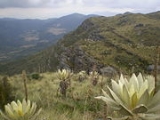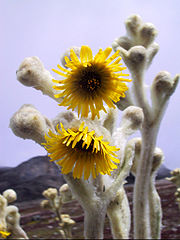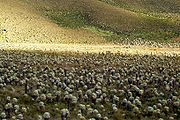
Espeletia
Encyclopedia
Espeletia, commonly known as Frailejón or Fraylejón is a genus
of perennial subshrubs, in the family Asteraceae
. The genus, which is endemic mainly to Colombia
, Venezuela
and Ecuador
, was first formally described by botanist Alexander Von Humboldt
in 1801. The genus was named after the New Granada viceroy
José Manuel de Ezpeleta
.
There are about 88 species in this genus, some of which are native to Colombia. The plants live at high altitude in the Páramo
ecosystems. The trunk is thick, with succulent hairy leaves disposed in a dense spiral pattern. Marcescent leaves help protect the plants from cold. The flowers are usually yellow, similar to daisies.
The status of conservation of the Frailejon plant is endangered due to destruction of the páramo for agricultural purposes, especially potato
crops. This activity continues, despite the fact that it was declared illegal by the Colombian government.
Species include:

Genus
In biology, a genus is a low-level taxonomic rank used in the biological classification of living and fossil organisms, which is an example of definition by genus and differentia...
of perennial subshrubs, in the family Asteraceae
Asteraceae
The Asteraceae or Compositae , is an exceedingly large and widespread family of vascular plants. The group has more than 22,750 currently accepted species, spread across 1620 genera and 12 subfamilies...
. The genus, which is endemic mainly to Colombia
Colombia
Colombia, officially the Republic of Colombia , is a unitary constitutional republic comprising thirty-two departments. The country is located in northwestern South America, bordered to the east by Venezuela and Brazil; to the south by Ecuador and Peru; to the north by the Caribbean Sea; to the...
, Venezuela
Venezuela
Venezuela , officially called the Bolivarian Republic of Venezuela , is a tropical country on the northern coast of South America. It borders Colombia to the west, Guyana to the east, and Brazil to the south...
and Ecuador
Ecuador
Ecuador , officially the Republic of Ecuador is a representative democratic republic in South America, bordered by Colombia on the north, Peru on the east and south, and by the Pacific Ocean to the west. It is one of only two countries in South America, along with Chile, that do not have a border...
, was first formally described by botanist Alexander Von Humboldt
Alexander von Humboldt
Friedrich Wilhelm Heinrich Alexander Freiherr von Humboldt was a German naturalist and explorer, and the younger brother of the Prussian minister, philosopher and linguist Wilhelm von Humboldt...
in 1801. The genus was named after the New Granada viceroy
Viceroyalty of New Granada
The Viceroyalty of New Granada was the name given on 27 May 1717, to a Spanish colonial jurisdiction in northern South America, corresponding mainly to modern Colombia, Ecuador, Panama, and Venezuela. The territory corresponding to Panama was incorporated later in 1739...
José Manuel de Ezpeleta
José Manuel de Ezpeleta
José Manuel de Ezpeleta y Galdeano, 1st Count of Ezpeleta de Beire was a Spanish military officer and politician, governor of Cuba from 1785 to 1789, and viceroy of New Granada from 1789 to 1797.A knight of the Order of Charles III and of the Royal and...
.
There are about 88 species in this genus, some of which are native to Colombia. The plants live at high altitude in the Páramo
Páramo
The term páramo can refer to a variety of ecosystems. Some ecologists describe the páramo broadly as “all high, tropical, montane vegetation above the continuous timberline”. A more narrow term classifies the páramo according to its regional placement - specifically located in “the northern Andes...
ecosystems. The trunk is thick, with succulent hairy leaves disposed in a dense spiral pattern. Marcescent leaves help protect the plants from cold. The flowers are usually yellow, similar to daisies.
The status of conservation of the Frailejon plant is endangered due to destruction of the páramo for agricultural purposes, especially potato
Potato
The potato is a starchy, tuberous crop from the perennial Solanum tuberosum of the Solanaceae family . The word potato may refer to the plant itself as well as the edible tuber. In the region of the Andes, there are some other closely related cultivated potato species...
crops. This activity continues, despite the fact that it was declared illegal by the Colombian government.
Species include:


- Espeletia grandiflora Humb&Bonpl.
- Espeletia killipii Cuatrec.
- Espeletia uribei Cuatrec.
- Espeletia pycnophylla Cuatrec.
- Espeletia schultzii (Benth.) W.M.Curtis
- Espeletia curialensis

